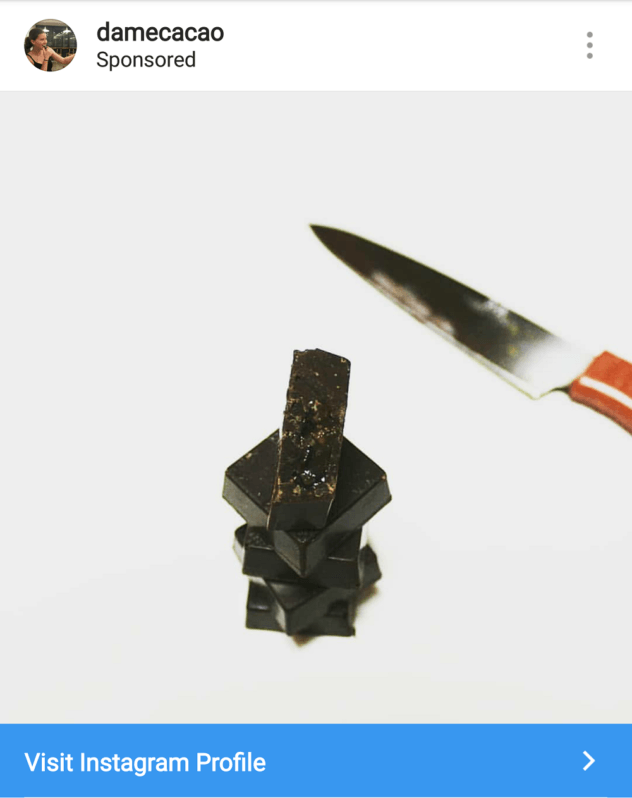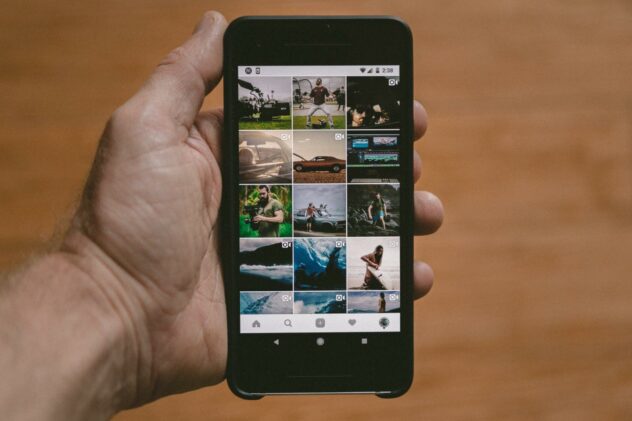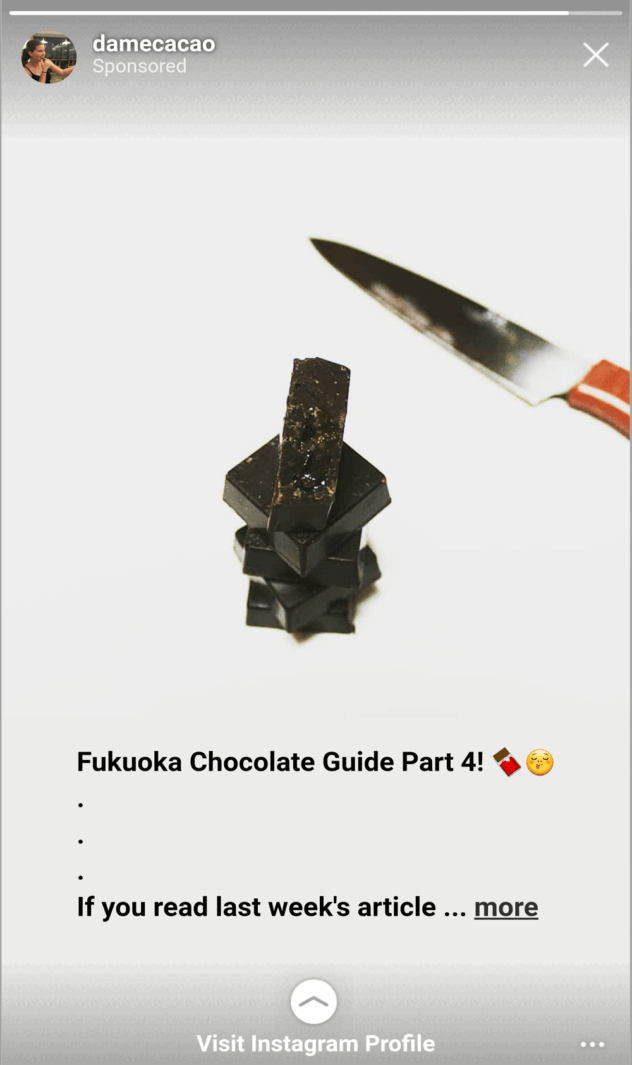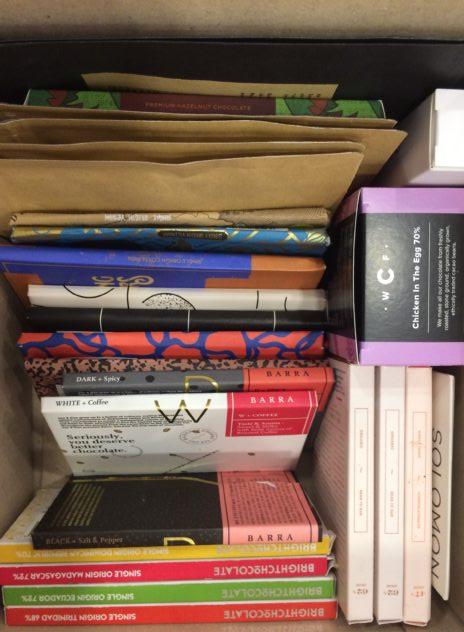Instagram is a free platform you can use to make connections with any people who want to connect with you.
That's it.
So how do you use it for your business?
Simple: you entertain the people; entertainment and attention retention is the key to your success on Instagram. The internet opened up a lot of different platforms which now demand our attention, and Instagram is one of the world's biggest. Owned by Facebook, it's also integrated ads into the platform over the last few years, and those ads have become quite valuable and are based in quality. Knowing and using it is how to use Instagram to successfully grow your business.
In this article we'll review the basics of creating and running and Instagram ad, as well as how to contact relevant "Instagram influencers." As the chocolate community grows, so does the pool of potential customers— but that doesn't mean they'll be coming to you. It's your job to put in the elbow grease.
This is Part 5 in a yearlong series on social media for chocolate businesses. Read every article in this series to get the full background information discussed below. Part 1: Social Media Basics for Chocolate Businesses. Part 2: How to Use Instagram For Your Small Business. Part 3: Creating Better Content on Instagram. Part 4: Crafting an Engaged Instagram Audience.
What is an Instagram Ad?
An Instagram ad is a regular Instagram post that a brand or company has chosen to pay to promote. Instagram has integrated ads, meaning that the "sponsored" pictures they show look just like any of the other photos or videos in your feed, except that they were targeted specifically at you.
Note that before you can run an Instagram ad, you need to have a business account on Instagram. Some people have pointed out that business accounts seem to reach fewer people "organically," meaning when Instagram shows your picture to your followers without you paying for it. But everyone still agrees that the benefits of having the statistics on your followers far outweighs the lowered consumer reach. Plus, with good pictures and captions, you can more than make up for the loss.
So what do you do if you decide to run ads?
Well, first of all you should know that once you've run one ad on Facebook or Instagram, the platform will continue to prompt you to run ads. They'll send you notifications on Instagram and Facebook, show potential ad previews in your feeds, and tell you when a post is doing well and should be promoted. This gets annoying. But you can & should use it to your advantage, as the most effective ads are pictures that were unusually popular with your base audience, meaning the people already following you.
Facebook & Instagram are trying to make money for themselves by helping you make money by creating the most effective ads possible.
How To Run an Instagram Ad
Once you've decided to run an ad, Instagram's platform can seem intimidating. But in reality, the platform is just giving you a variety of options that it benefits you to understand.
Choice number 1: do you want more followers or more customers? You can choose from Your "Profile" or "Website" or "Storefront," and at the bottom of the page you'll find more information on what this choice means for the people who sees your ad. This step is basically asking why you want to run an ad.
Choice number 2: who do you want to see your ad? You can choose from "Automatic" or "Manual." If you choose "Automatic," Instagram will show your ad to people similar to those who already follow you. If you choose "Manual," you have a bevy of options that I implore you to take advantage of. You can choose the physical location, interests, age range, and gender of your ideal audience. When choosing your ideal audience, it's important to have a customer avatar already in mind before putting together your ad, otherwise you might as well be shooting in the dark.
Choice number 3: how much do you want to spend and for how long? Consider if this is an ad promoting a seasonal product or class, or if it's something you'd choose to promote again or for a long time. Under "Budget" you choose how much to spend on this one ad, while under "Duration" you choose the length of time over which you'll spend your budget.
I'd recommend at least $20USD per ad, with at least $2USD spent per day. The longer your ad runs, the more likely it is that more people will see it. As you adjust these two numbers, you'll see your "Estimated Reach" change, meaning that the potential number of people who see your ad changes.
After you make those three choices, your ad is all set and you just need to review the information you've already entered. After Instagram approves the ad as appropriate, it'll start being shown to people. For a step-by-step tutorial on creating an Instagram ad, read this.

Designing Your Ad
When making, taking, or choosing the picture that will become your Instagram ad, it's crucial to keep in mind your brand's image. This could be you as a person, your product, or your unique selling point, among other things.
The most important design choice is presenting an image which represents your brand well. If people see the picture in their feed and click, it's because they want to see more of what they clicked on. So if that particular picture is a good representation of what your brand usually shares, then that might make a good ad.
The bottom line is to know your brand's aesthetic & base your ad off of this overall aesthetic.
For every picture on your feed, the goal is to first be eye-catching, so always use beautiful and compelling pictures. Free resources like Canva can help you design and save ads for the future, as well as give you inspiration through their millions of free stock photos. Keep in mind that photos with text tend to get overlooked more than regular photos. Consider how much money you want to spend on the ad and weigh that against how much time & effort you're putting into it.
Spending at least $20USD per ad, run several ads over the course of a week. Compare how well they do and identify what the best performing ad did better than the rest, then improve from there. But don't give up until you've spent at least a few hundred dollars on ads. If you can't afford to spend that much on marketing, then you shouldn't be running ads in the first place.
Consider running a giveaway that requires people to follow you and tag their friends, and then promoting the giveaway. The tagging their friends part is most important here, as it basically has your existing followers finding new followers for you.

Identifying Your Target Audience
Knowing your target audience is just as important as putting out a compelling and eye-catching ad. Unlike more traditional ads, which are shown to whomever happens to be watching that show or driving on that highway, social media ads are highly targeted. So when an Instagram ad is both well-designed and well-targeted, it will reach more people.
It's like putting the same amount of fuel is two different cars— one's an efficiently designed tesla and the other's an ancient pickup truck. Which will go further on 5 gallons?
To hand-select the demographics of the audience for your post, you must select "Manual" under "Audience" for your promotion. There you can consider and target specific age ranges, genders, locations, and hobbies of potential readers or customers. If you choose to target through Facebook first, you can get even more specific (see below). This is where your ideal customer avatar comes in, and why it's important to know exactly what you're selling before you try to sell it.
For example, this website and its associated content are focused on chocolate travel, so that's what we share information about. Using the demographics of both our Instagram following and the people who visit the site, we can create an ideal customer avatar and enter in their demographics, and ideally have more people visit our site.
It's essential to know what topics your potential customers are interested in and therefore what they expect in their feed. This way they don't immediately single out your picture as an ad and scroll right past without ever getting far enough to see what you're all about. If you're trying to sell a chocolate bar, consider the ages of people who could afford to buy it, the seasonality of such an item, the interests of a person willing to pay more for chocolate, and how you can catch their eye by blending in rather than standing out.
Learn more about identifying your target audience here.

IG Story Ads vs. Regular Feed
Before addressing Facebook's role in Instagram, let's address a common question I get: Instagram story ads or Instagram feed ads?
When making Instagram ads, you have two options for where those ads go within Instagram: in the regular news feed, or in stories. If you've ever scrolled Instagram, you've definitely seen these advertisements, with the location marker just saying "sponsored." But you as an Instagram user may never look at the stories which the people you follow post. If you don't, then you're not alone. But if you do, then you're also not alone. An increasing number of Instagram users is getting into the stories feature, and it's not all the under-30 crowd, but there is a slight learning curve when it comes to ads.
When choosing to run your first few Instagram ads, you may want to restrict it to the news feed until you get a hang of it all. In my experience, about 7 to 10% of my followers watch my stories, while 30 to 50% see my regular posts. Note that "Reach" is different from "Impressions" in that reach tells you how many individual people saw the post while impressions tells you how many times it was seen by anyone. But this doesn't indicate the number of people who interact with these posts in any way, and it may even be an advantage.
Here's why.
Stories are still a relatively new feature, around a year old, so not all users use them as they use the regular feed. Additionally, to create an Instagram stories ad you previously either need to download Facebook's platform, Creative Hub, or create the ad through your business's Facebook page. So thanks to its newness, the ads there are even more valuable; the cost to reach people there is still cheaper than in the main feed.
With similar functionality & appearance available between story ads and feed ads, it's difficult to say which platform has more of an attention grab. But the truth is undeniable: Instagram Stories are an undervalued ad platform.
Read about an experiment comparing Instagram Feed ads versus Story ads here.

Cross-Posting Ads on Facebook
I've always believed that if you have a resource at your disposal, you should use it.
Enter: the power of Facebook.
If your business doesn't have a Facebook page, then what are you doing with yourself?! Go make it one, or claim the page that Facebook made for it. Since Instagram is owned by Facebook, and Facebook is the older company, for all intents and purposes Facebook sees Instagram as an extension of itself (rather than the other way around). So not only are their targeting capabilities much more refined— almost eerily so— but they also don't actually require you to have an Instagram account.
Since the ad originates on Facebook, you also can't have any of those ads pointed towards your Instagram account. This means that cross-promoted ads are more suited for brand awareness or selling a specific product. But creating ads through Facebook does allow you to target consumers in even more specific demographics.
In fact, Facebook has some amazing resources for anyone looking to advertise on their platforms, especially helpful for those of you just getting started in marketing. Even if you decide not to run through Facebook first, just by reading through their advertising guidelines you can get a leg-up in understanding the psychology and terminology of online & social media advertising.
Even though this site is a one-woman labor of love, I've been experimenting with running ads on Instagram (via Facebook, as well) for several months now to test out a variety of theories. Thanks to pure curiosity, I've found that the more on-brand but unexpected that a picture was, the more people clicked to view my profile. The photos with more engaging captions or which were connected to some kind of movement or hashtag (rather than just promoting my latest article), got more profile visits and likes.
Just like Google Ad Words was an undervalued platform 15 years ago, social media advertisements and social media "influencers" are highly undervalued right now. In exchange for how many people they can reach and how specifically you can target audiences, if you don't put a majority of your advertising budget into social media, then you're making a mistake. The affordability of advertising through both means won't be the case a few years from now, and it will cost much more to reach your potential customers & audience. But for now, we can all take full advantage of paying less than $10 to reach a thousand potentially-interested consumers, and bask in it while it's here.
Click here to read an article on creating Facebook ads. Just before your ad is submitted there will be an option to also promote the ad on Instagram (in feed or stories), and approve how it looks on both platforms.
Chocolate Instagram Influencers
I've seen many chocolate companies start to use Instagram influencers as a tool, and I clearly think it's really smart. As a chocolate writer, I don't accept brand ambassadorships or anything of the sort since it could affect how people perceive what I write. However, I think that most people with at least a few thousand followers would be very happy to take free chocolate or other products in exchange for a promotion on their Instagrams. These aren't necessarily people who are involved in chocolate or who consider themselves influencers, but people whose audiences you'd be interested in accessing.
Consider this scenario: You're a chocolate maker located in the mid-western US, and you're already running ads promoting your online store for people living in your town. You're also promoting pictures of a recent kids chocolate making workshop to people within a 10 mile radius of your store, with the goal to make it a weekly event. But you want to step up your game. So you look for moms who follow you and have already liked some of your photos. Then, of those women you identify the ones with between 1K-3K followers, and direct message them offering a free class for them and their kids in exchange for an Instagram post or two.
In the scenario above you'd have to work out the exact details of the exchange, but even just offering to send these "micro-influencers" some free chocolate has the potential to give your company some good exposure and lots of goodwill from the moms and their friends.

There are sites you can use to estimate how much to pay a larger influencer for their promotion, but always offer the product for free first (be clear that you'd like them to post an honest review of it). If they tell you something along the lines of "I'm currently prioritizing paid promotion," then you can either ask for their rates or move on to the next influencer. If they have a much larger following, maybe local to your area, it's perfectly reasonable to pay them for a shout out as long as they have people legitimately listening to what they say.
You can also use influencers as part of a giveaway, asking them to promote the giveaway as part of the deal. This is a tricky field in which to play, however, as there are undoubtedly "influencers" who've bought their followers and likes and comments. This brings me to the question of determining whether an account's followers are "real." This site has a good reputation for being able to estimate "real" following of accounts.
To get estimates on how much to pay an influencer for an ad, the general rule on Instagram is about $10 per thousand followers, but this varies greatly depending upon the quality of the audience. For small businesses, finding local or suitable influencers through an influencer network can seem impossible. Check out this article for alternative avenues for finding local influencers.
Further Resources
I'm a chocolate & travel writer who does all the work behind this site— its promotion, the podcast, Youtube, Facebook, etc.— for free. I don't sell anything, or make any money off of it. So if you're using ads to sell something rather than raise awareness of your brand, then your chocolate marketing strategy can be broader. Check out these resources to continue your learning about Instagram and other social media platforms.
- How to effectively run A/B testing on ads {article}
- How to target customers in a "buying mindset" {article}
- How to market to a local audience {article}
Most people seem to either be under the misguided notion that if their brand is good, people will find it. Others believe that only suckers pay for promotion these days. Both presumptions are dangerous for your business, especially in an increasingly saturated market. There's still room for growth in many places, but if you're opening a chocolate business in most any metropolitan area in the world, then you have a marketing strategy by default, even if that means that you choose to do nothing.
Ignorance is bliss until growth goes stagnant.
Now that you've learned how to run an effective Instagram ad, be sure to go back and review the previous articles in the series:
Chocolate Marketing 101: Social Media Basics for Chocolate Businesses
Chocolate Marketing 102: How to Use Instagram For Your Small Business
Chocolate Marketing 103: Creating Better Content on Instagram
Chocolate Marketing 104: Crafting an Engaged Instagram Audience
Pin me for later!

















Leave a Reply